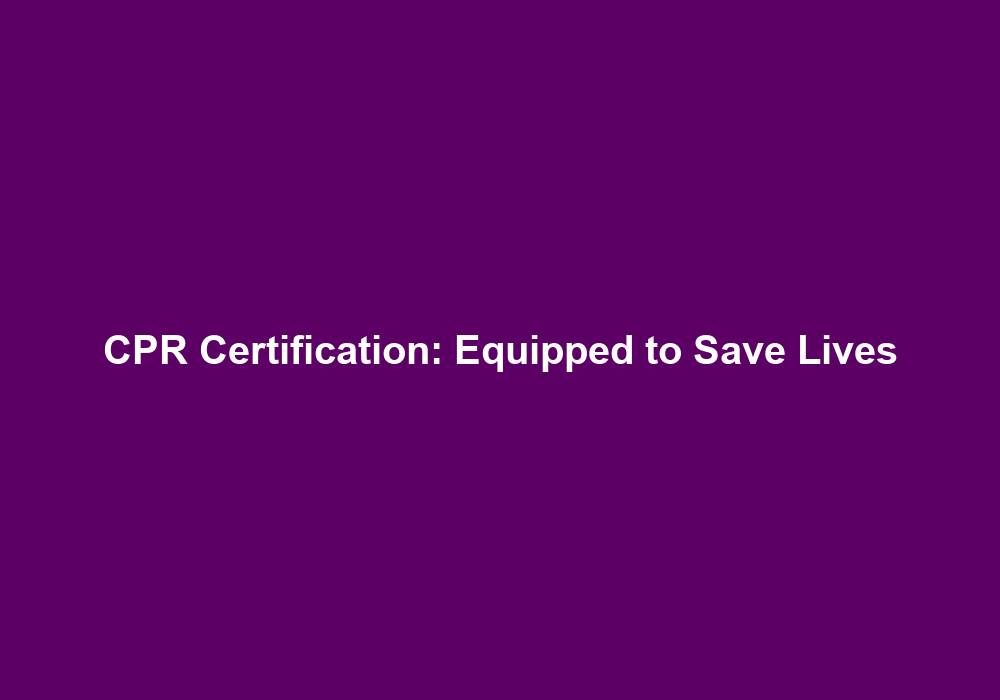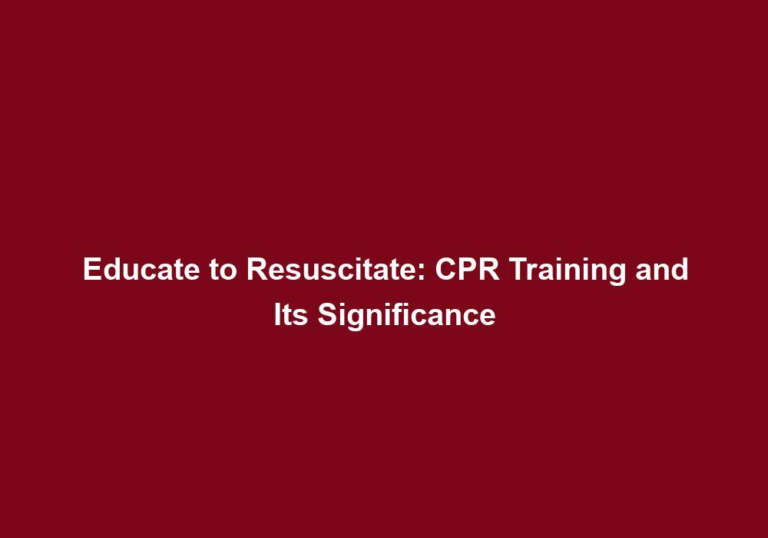CPR Certification: Equipped to Save Lives
Cardiopulmonary Resuscitation (CPR) is a life-saving technique used in emergency situations when someone’s heart or breathing has stopped. It involves providing chest compressions and rescue breaths to maintain blood circulation and oxygenation until professional medical help arrives. CPR certification equips individuals with the knowledge and skills to respond effectively in such critical situations, potentially saving lives.
Why CPR Certification Matters
-
Immediate Response: Accidents and medical emergencies can occur anywhere, anytime. Having CPR certification enables individuals to respond quickly and confidently in the crucial minutes before professional medical help arrives.
- Being trained in CPR allows individuals to take immediate action when someone experiences cardiac arrest or stops breathing. By performing chest compressions and rescue breaths, the certified person can help maintain oxygen supply to the vital organs until professional help arrives.
- Prompt response is essential in increasing the chances of survival. Studies have shown that for every minute without CPR, the chances of survival decrease by 7-10%. Having CPR certification empowers individuals to provide immediate assistance, potentially doubling or even tripling the survival rates.
-
Increased Survival Rates: The prompt administration of CPR significantly improves the chances of survival for individuals experiencing cardiac arrest. Studies have shown that starting CPR immediately can double or even triple the survival rates.
- CPR helps to circulate oxygen-rich blood to the brain and other vital organs, preventing irreversible damage and increasing the chances of survival.
- By obtaining CPR certification, individuals gain the knowledge and skills to perform high-quality CPR, including proper compression depth, rate, and technique, as well as effective rescue breaths. These skills are crucial in maximizing the chances of survival for someone in need.
-
Empowerment: CPR certification empowers individuals to make a difference in their communities by being prepared to assist in emergencies. It provides them with the tools and knowledge to potentially save a life.
- Being CPR certified instills confidence in individuals, allowing them to take immediate action during emergency situations.
- By obtaining CPR certification, individuals become valuable assets in their communities, capable of providing life-saving assistance when every second counts.
-
Workplace Requirements: Many workplaces, such as healthcare facilities, schools, and fitness centers, require employees to hold CPR certification. It is often a mandatory requirement due to the potential risks and the need for immediate action in these settings.
- In healthcare settings, CPR certification is crucial for healthcare professionals, as they are often the first responders to medical emergencies. It ensures that they are equipped to provide immediate and effective care to patients in critical situations.
- Schools and fitness centers also prioritize the safety and well-being of their students and clients, making CPR certification a requirement for their staff. By having certified individuals on site, these establishments can respond promptly to emergencies and potentially save lives.
How to Get CPR Certified
-
Training Programs: Numerous organizations and institutions offer CPR certification courses, both in-person and online. These programs are designed to teach participants the necessary skills, techniques, and guidelines for performing CPR correctly.
- When choosing a CPR certification program, it is important to select a reputable organization that follows the latest guidelines and standards.
- In-person courses provide hands-on training, allowing participants to practice CPR techniques on mannequins or simulators under the guidance of experienced instructors.
- Online courses offer flexibility and convenience, allowing individuals to learn at their own pace. However, it is crucial to ensure that the online program includes interactive elements and assessments to ensure competency.
-
Course Curriculum: CPR certification courses typically cover topics such as basic life support, adult, child, and infant CPR techniques, proper use of automated external defibrillators (AEDs), and responding to choking emergencies.
- Basic life support training provides individuals with a foundation in CPR techniques and guidelines, ensuring they are prepared to respond in various emergency situations.
- CPR techniques may vary depending on the age and size of the individual in need. Certification courses cover the appropriate techniques for adults, children, and infants.
- Training on the proper use of AEDs is essential, as these devices can significantly improve the chances of survival for someone experiencing cardiac arrest.
- Choking emergencies can also be life-threatening, and CPR certification courses teach participants how to respond effectively to these situations.
-
Hands-on Practice: To become proficient in CPR, hands-on practice is essential. CPR certification courses usually include practical sessions where participants can practice their skills on mannequins or simulators. This practice ensures that individuals gain the confidence and muscle memory required to perform CPR effectively.
- Hands-on practice allows individuals to refine their CPR techniques, ensuring they are performing the correct chest compressions and rescue breaths.
- Instructors can provide real-time feedback and guidance during practical sessions, helping participants improve their skills and increase their confidence.
- Repetition of hands-on practice enables individuals to develop muscle memory, allowing them to perform CPR effectively even in high-pressure situations.
-
Certification Validity: CPR certification is typically valid for a certain period, often two years. After this time, individuals must renew their certification by taking a refresher course and demonstrating their knowledge and skills.
- Regular renewal of CPR certification ensures that individuals stay updated with the latest guidelines and techniques.
- Refresher courses provide an opportunity for individuals to review and reinforce their CPR skills, ensuring that they are prepared to respond effectively in emergency situations.
The Importance of CPR Training for Different Groups
1. General Public
CPR training is beneficial for everyone, regardless of their profession or background. The general public can greatly contribute to saving lives by being CPR certified. Some key points to consider include:
- Immediate Response: In emergency situations, the presence of individuals with CPR certification can be vital in providing immediate care while waiting for professional help. Prompt CPR can significantly increase the chances of survival.
- Family and Friends: CPR certification enables individuals to respond effectively during emergencies involving their loved ones. Having the knowledge and skills to perform CPR can make a significant difference in critical situations.
- Community Impact: By obtaining CPR certification, individuals become valuable assets in their communities, capable of providing life-saving assistance when needed. They can contribute to creating safer environments and potentially save lives.
2. Healthcare Professionals
For healthcare professionals, CPR certification is often a prerequisite for employment. However, staying up-to-date with the latest guidelines and techniques is equally important. Some essential aspects for healthcare professionals include:
- Standardized Techniques: CPR certification ensures that healthcare professionals adhere to standardized techniques and guidelines. This consistency is crucial in emergency situations, where coordination and teamwork are vital.
- Professional Obligation: Healthcare professionals have a moral and ethical obligation to provide the best possible care to their patients. Being CPR certified allows them to fulfill this obligation, particularly in high-risk environments such as hospitals and clinics.
- Continuing Education: CPR certification is not a one-time achievement for healthcare professionals. They must stay updated with the latest advancements in CPR techniques and guidelines through regular training and continuing education. This ensures that they provide the most effective care to patients in need.
3. Teachers and School Staff
Schools are responsible for the safety and well-being of their students. CPR certification for teachers and school staff offers the following advantages:
- Emergency Preparedness: In schools, CPR certification enables staff to respond effectively to medical emergencies involving students. This preparedness can significantly improve the outcomes in critical situations.
- Role Models: Teachers and school staff with CPR certification serve as role models for students, inspiring them to learn and prioritize life-saving skills.
- Collaboration with Healthcare Professionals: CPR certification allows teachers and school staff to work collaboratively with healthcare professionals during emergency situations. This teamwork enhances the overall response and increases the chances of successful outcomes.
Conclusion
CPR certification equips individuals with the essential knowledge and skills to respond effectively in emergency situations. With the ability to administer CPR, individuals can potentially save lives, increasing the chances of survival for those experiencing cardiac arrest. Whether you are a member of the general public, a healthcare professional, or work in a school setting, CPR certification is a valuable investment that enables you to make a difference when every second counts. Get certified today and be prepared to save lives.







